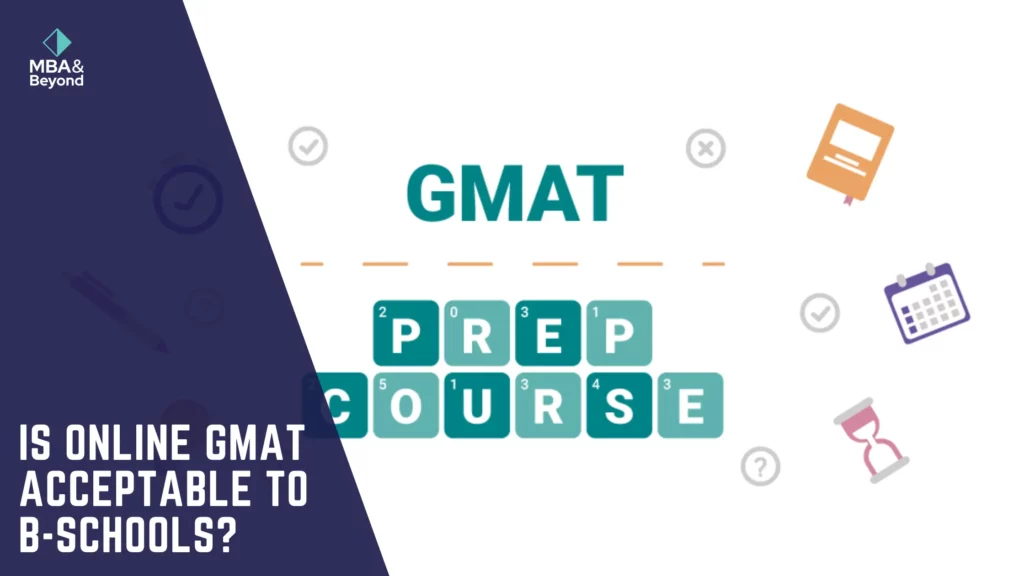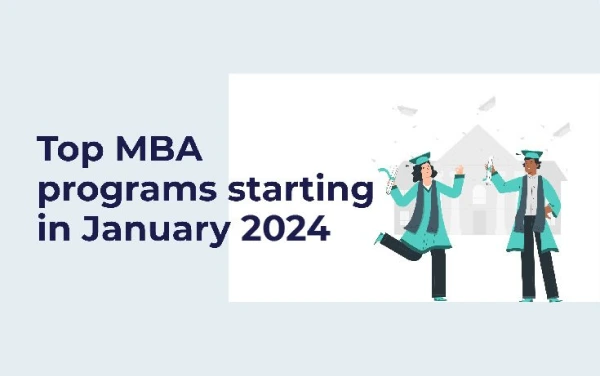Is Online GMAT acceptable to B-schools?

The Graduate Management Admission Test (GMAT) has long been a cornerstone of the business school application process. It serves as a critical measure of a candidate’s potential for success in graduate management programs. Traditionally, aspiring MBA students have flocked to testing centers worldwide to take this exam. The GMAT assesses analytical writing, integrated reasoning, quantitative, and verbal skills. However, the landscape of standardized testing underwent a significant transformation with the advent of the Online GMAT B-schools, introduced primarily in response to the global disruptions caused by the COVID-19 pandemic.
The introduction of the Online GMAT was a game-changer, offering candidates the flexibility to take the exam from the comfort of their homes. This innovation sparked numerous questions about its legitimacy and acceptance among business schools. In this blog post, we will explore whether B-schools accept the Online GMAT, examining trends, specific cases, and the overall perception of this new format among top institutions.
What is the Online GMAT?
The Online GMAT is a remote version of the traditional GMAT, designed to provide test-takers with a convenient and safe way to complete the exam during times when attending a test center is not feasible. Launched in April 2020, the Online GMAT maintains the same structure and scoring system as the traditional exam but offers added flexibility.
Differences Between the Online GMAT and Traditional GMAT:
- Test Environment: The Online GMAT can be taken at home or any quiet, private location, eliminating the need to travel to a testing center.
- Test Structure: Both versions include the same sections: Analytical Writing Assessment (AWA), Integrated Reasoning (IR), Quantitative, and Verbal. However, the Online GMAT initially did not include the AWA section, though it was later reinstated.
- Scheduling: The Online GMAT offers more flexible scheduling options, including availability 24/7.
- Proctoring: The Online GMAT is proctored remotely using advanced AI and human proctors to ensure test integrity.
Advantages of the Online GMAT:
- Convenience: Allows candidates to take the test from their preferred location.
- Flexibility: Offers a wide range of scheduling options.
- Safety: Reduces exposure to potential health risks associated with in-person testing.
Disadvantages of the Online GMAT:
- Technical Issues: Potential for internet connectivity problems or computer malfunctions.
- Test Environment Control: Ensuring a distraction-free environment at home can be challenging.
- Proctoring Limitations: Remote proctoring may not always match the stringency of in-person monitoring.
B-schools’ Acceptance of the Online GMAT
When the Online GMAT was first introduced, many students were concerned about its acceptance by business schools. Initially, there was uncertainty as schools adapted to the new testing format. However, as the pandemic persisted, a significant number of institutions recognized the need to accommodate this change.
General Acceptance Trends:
- Most top-tier business schools quickly adapted to the new format, understanding the challenges posed by the pandemic.
- Acceptance of the Online GMAT has grown, with many schools stating explicitly on their admissions pages that they accept scores from both the Online GMAT and the traditional GMAT.
Specific Examples:
- Harvard Business School: Clearly states that they accept both the Online GMAT and the traditional GMAT, with no preference for either format.
- Stanford Graduate School of Business: Accepts the Online GMAT and emphasizes the importance of the overall application rather than the test format.
- Wharton School at the University of Pennsylvania: The school recognizes the Online GMAT as a valid test option, assuring applicants that it will consider their scores equally.
Case Studies and Quotes from Admissions Officers:
- Kellogg School of Management (Northwestern University): An admissions officer commented, “We understand the unprecedented times and are committed to being flexible and fair in our evaluation process, which includes accepting the Online GMAT.”
- INSEAD: Another leading B-school, INSEAD, noted, “The Online GMAT offers the same rigor and validity as the traditional test, and we have full confidence in considering these scores for our admissions process.”
Comparing Online GMAT and Traditional GMAT Scores
The acceptance and perception of Online GMAT scores by business schools have evolved significantly since its introduction. Initially, there was skepticism about whether the Online GMAT would be considered equivalent to the traditional in-person test. However, many business schools have now recognized the Online GMAT as a valid and reliable alternative.
Score Validity and Reliability: Research and feedback from both students and educators suggest that the Online GMAT maintains the same level of rigor and fairness as the traditional GMAT. The scoring algorithm remains consistent, ensuring that scores from both formats are comparable. The Online GMAT includes the same sections—Analytical Writing Assessment, Integrated Reasoning, Quantitative, and Verbal—ensuring a comprehensive evaluation of candidates’ skills.
B-schools’ Perspective: Business schools, including top institutions like Harvard Business School and Stanford Graduate School of Business, have explicitly stated that they accept Online GMAT scores. Additionally, schools like MIT Sloan, Chicago Booth, and INSEAD have confirmed their acceptance of the Online GMAT for the 2023-2024 admissions cycle. The main concern for schools has been maintaining the integrity and fairness of the testing process. However, this issue has been addressed through remote proctoring and AI monitoring systems implemented for the Online GMAT.
Testimonials from Students: Many students who have taken the Online GMAT report positive experiences. They appreciate the flexibility and convenience it offers. Moreover, they have found that the preparation strategies remain largely the same, with only minor adjustments to account for the online format. Additionally, the ability to take the test from home has reduced the stress associated with traveling to test centers, which can positively impact performance.
For more details, go through the page.
Want to pursue an MBA but not sure if your profile fits?
Talk to our Profile Experts to know your chances for a top MBA Program.
GET A FREE PROFILE ANALYSISPros and Cons
Pros:
- Flexibility and Convenience:The Online GMAT can be taken from any location with a stable internet connection. Consequently, this provides greater flexibility in scheduling and eliminates the need to travel to a test center.
- Safety: Especially relevant during the COVID-19 pandemic, the Online GMAT allows candidates to take the test in a safe environment, minimizing health risks.
- Immediate Score Preview: Test-takers can view their unofficial scores immediately after completing the exam, helping them make quick decisions about their next steps.
Cons:
- Technical Challenges: The Online GMAT requires a reliable internet connection and a computer that meets specific technical requirements. Any disruption during the test can cause significant issues.
- Home Environment: Maintaining a distraction-free environment at home can be challenging. Test-takers must ensure a quiet and uninterrupted space to perform optimally.
- Remote Proctoring Issues: Although remote proctoring is effective, it may not be as stringent as in-person proctoring. Some test-takers may find the monitoring software intrusive or experience technical glitches.
The acceptance of the Online GMAT by business schools and the experiences of test-takers highlight its viability as an alternative to the traditional GMAT. Furthermore, with the growing number of schools recognizing the Online GMAT, students can confidently choose this option without fearing any disadvantage in their applications.

Preparing for the Online GMAT
Preparing for the Online GMAT involves understanding the format, establishing a solid study plan, and using the right resources. Here are some effective strategies:
- Understand the Exam Format:
- The Online GMAT includes the same sections as the traditional GMAT: Analytical Writing Assessment (AWA), Integrated Reasoning (IR), Quantitative, and Verbal. Familiarizing yourself with the exam structure is crucial to effectively prepare for each section.
- Create a Study Plan:
- Start by assessing your current skill level in each section. Allocate more time to areas where you need improvement. A phased approach is recommended: begin with building foundational skills, then move to intensive practice, and finally focus on revision and fine-tuning your test-taking strategies as the exam date approaches.
- Use Official Prep Materials:
- Utilize resources like the GMAT™ Official Guide, online question banks, and practice exams. These materials are designed to mimic the actual test experience and provide detailed explanations for each question. Taking official practice exams helps you gauge your performance and identify areas for improvement.
- Focus on Section-wise Preparation:
- Quantitative Section: Practice a variety of problem types, including data sufficiency and problem-solving. Mastering fundamental concepts in algebra, geometry, and arithmetic is essential. Regular practice and learning shortcuts can improve your efficiency.
- Verbal Section: Develop strong reading comprehension, critical reasoning, and sentence correction skills. Engage with complex texts to enhance your comprehension and analytical abilities. Practice identifying argument structures and understanding logical fallacies.
- Analytical Writing Assessment: Focus on formulating clear thesis statements and structured arguments. Practice writing under timed conditions to manage the time constraint effectively.
- Integrated Reasoning: Enhance your ability to analyze and synthesize data from various sources. Practice interpreting graphs, tables, and passages to quickly identify relevant information.
- Simulate Test Conditions:
- Take practice exams under conditions that simulate the actual test day. This includes using the same timing and tools allowed during the test. This practice helps build confidence and improve time management skills (e-GMAT) (Studential).
Conclusion
The acceptance of the Online GMAT by top business schools and the experiences of test-takers highlight its viability as an alternative to the traditional GMAT. Schools such as Harvard, Stanford, and MIT Sloan recognize the Online GMAT, ensuring that applicants are not disadvantaged by the format. Preparing for the Online GMAT involves understanding the exam structure, creating a detailed study plan, and using official prep materials to enhance your skills in each section.
With the right preparation strategy, students can perform well on the Online GMAT and confidently apply to their desired business schools. Whether you choose the Online GMAT or the traditional format, thorough preparation and practice remain the keys to success.



Leave a Reply